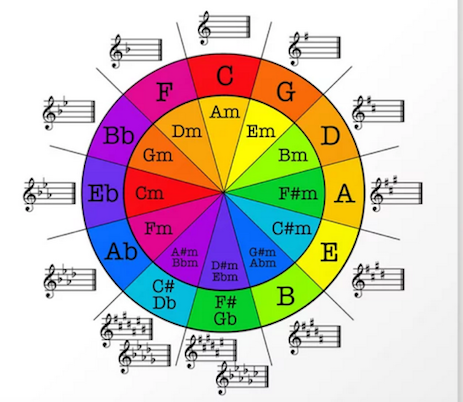Welcome back to my music theory series. Every month in 2021 I’ll be covering a different music theory topic. This month’s topic is the circle of fifths.
What is the circle of fifths? Well in it’s most basic definition it’s a way of organizing the 12 chromatic (step by step) pitches as a sequence of perfect fifths. If C is chosen as a starting point, the sequence is: C, G, D, A, E, B, F sharp/G flat, C sharp/D flat , A flat, E flat, B flat, F. Continuing the pattern from F returns the sequence to its starting point of C.
Lets take a look at the circle of fifths diagram below…

So as you can see if you start at the noon position on the outer ring of C and moving clockwise you’ll notice C to G is a fifth. Count it with me starting on C…
C, D, E, F, G.
C to G is a fifth.
Do it again starting on G.
G, A, B, C, D.
G to D is a fifth.
You can do this continually in a clockwise fashion around the circle. All the outer rings of the circle are major keys. All the inner rings are minor keys. I’ll go over different types of scales in future blog posts. For now we are just talking about major and minor scales. Think of major as happy and minor as sad.
If you start at the noon position of the circle on the inner ring you’ll notice it says A minor. So starting on A and count up a fifth. A, B, C, D, E.
A to E is a fifth.
Moving clockwise on the inner ring you’ll see E minor next. So starting on E.
E, F, G, A , B.
E to B is a fifth. You can do this moving in a clockwise fashion all the way around the inner ring of the circle for minor keys as well.
Outside the circle by each letter you’ll notice corresponding treble clef staffs for each major and minor key. So for example starting at the noon position the C Major scales would be C, D, E, F, G, A, B, C. Here’s what that scale would look like notated on the treble clef…

If you start on the inner ring in the noon position which is A minor, that would be A, B, C, D, E, F, G, A. Here’s what that would look like notated on the treble clef…

Despite the C major scale starting on C, and the A minor scale starting on A, both scales have something in common. Did you notice it?… They both share the fact that they contain no key signatures. There are no sharps or flats. Just natural notes. Because of this they are called relative scales.
Think of it this way… you and your biological family members share DNA. Well in this case these two scales are relative to each other because they share the same DNA of no sharps and no flats.
If you move clockwise on the circle of fifths diagram, you’ll notice the next major scale is G major. It’s relative minor is E minor. Why? You guessed it, they share one sharp note in their scales. In this case the sharp note is F sharp. Let’s take a look at the G major and e minor scale below…


As you can see above, despite these two scales starting on two different notes or pitches they are relative to each other because they both contain one sharp (F sharp)
As you move around the circle of fifths you can see this pattern with all the major and minor scales.
A couple good examples of my music using relative scales within a song are ‘Light & Shadow‘ which starts off in A Flat major and moves to it’s relative minor (F minor). The song goes back and forth between these two relative keys before ending in F minor.

Another example in the use of relative keys in my music is my song ‘Beyond Cloud Nine‘. The song starts off in D major and moves into it’s relative minor B minor.

Now that I’ve mentioned relative keys as it relates to the circle of fifths, I should also mention there is something called parallel keys. That is the notes of the scale are the same but the number of sharps or flats are different. For example here is the A minor scale again…

Now lets take a look at a parallel scale in A Major…

You’ll notice both scales start on A and end on A, making them parallel. However they are different in that A minor has no sharps and A Major contains 3 sharps in the key signature/scale. F sharp, C sharp, G sharp.
A good example in the use of parallel keys used in one of my songs is ‘Tabatha’s Song‘. The songs starts in A minor and moves back and forth between A minor and A Major before ending in A Major.

Have any questions about the circle of fifths or anything mentioned above? I’ll be happy to answer them. Until next time, work on memorizing the circle of fifths!



Thanks, this is wonderful! I’ve never heard or read this explained so clearly, and the uses of it as well.
Thanks for listening Sasha.